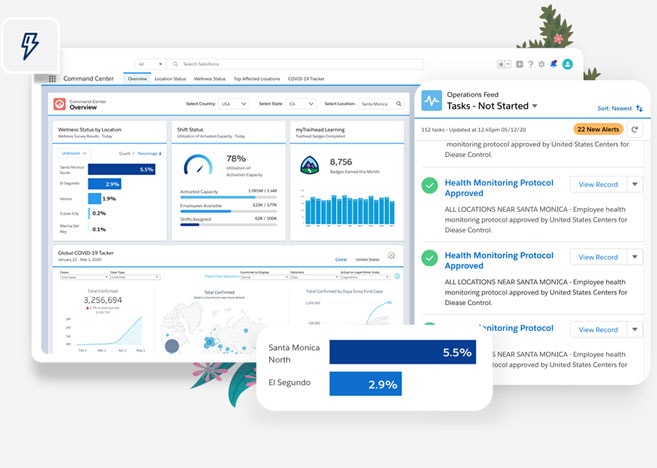Hybrid Work: How To Unlock the Benefits for Success in 2024
As organizations transition back to traditional in-office work models, many face resistance from a workforce accustomed to remote work life. Rather than risking the potential of a mass exodus from their workforce, organizations seek to find a balance between both worlds.
Enter the hybrid work model, a flexible approach combining traditional in-office and remote work. It offers employees the autonomy they crave and the work-life balance they deserve. But what exactly does hybrid work entail, and how can companies unlock its full potential?
Let’s dive into the world of hybrid work, explore its benefits and challenges, and uncover the secrets to implementing a successful hybrid work model.
This guide will discuss hybrid work, its benefits, challenges, and how to implement a successful hybrid work model for your business. We’ll also give real-world examples of hybrid work success with companies that have adapted to this new work model and reaped its benefits.
So, let’s start on this exciting journey to unlock the world of hybrid work and learn how to make it work for you and your organization.
Key Takeaways
- Hybrid work offers increased flexibility, work-life balance, enhanced productivity, and access to a global talent pool.
- Companies can successfully embrace hybrid work by recognizing collaboration & communication needs, managing remote employees, and fostering fairness & inclusion.
- Real-life examples demonstrate how organizations benefit from embracing this model through technology investment, creating a flexible culture, and customized arrangements.
Understanding Hybrid Work
Hybrid work combines traditional in-office and remote work, giving employees flexibility and work-life balance.
As COVID fears disappeared, many organizations tried to get employees to return to everyday office life. However, they found that many employees were relatively resistant to the idea.
In March 2023, Elon Musk emailed Twitter staff, stating that the “office is not optional.” Trying to enforce an injunction on employees. Even Amazon rejected an internal petition by its 30,000 employees to keep the remote work programs in place. This led to a walkout in May of 2023 by Amazon corporate workers in part of a protest to return-to-office policies.

Additionally, many organizations have fully adopted the remote work model, making them the employer of choice for many leaving their old jobs, even sacrificing higher pay for the flexibility of working remotely. This has forced many organizations to reevaluate their plans to return to the traditional in-office work model. Instead, they consider a hybrid model a compromise to avoid losing top talent to competitors with remote work opportunities.
As the future of work continues to develop, it is becoming apparent that hybrid work models provide a valuable solution for organizations seeking to adapt and thrive in this ever-changing landscape.
To truly understand these hybrid work models, we must first define them and then analyze how they have evolved. With this understanding, we can begin exploring the benefits and challenges associated with hybrid work and the strategies for implementing a successful hybrid work model.
Definition of Hybrid Work
Hybrid work is an incredibly flexible model that enables employees to work from physical and remote workspaces. This innovative approach allows employees to enjoy the best of both worlds, providing an office environment’s structure and social interaction while offering the freedom and flexibility to work remotely when needed.
The key pillars of hybrid work focus on the outcomes of hybrid workers rather than their location and hours worked. There are four types of hybrid work schedules:
- Cohort
- Staggered
- Set by managers
- DIY employee schedules
These schedules offer great flexibility and convenience for employees and employers who choose to work with them. Let’s review what each type is and what differentiates it from others.
1. Cohort Scheduling:
The Cohort schedule in a hybrid work model involves creating specific groups (or “cohorts”) of employees who work in the office on the same days and remotely on other days. These cohorts are meticulously designed to ensure that team members who benefit most from in-person collaboration are present together, optimizing knowledge sharing and collaborative ventures.
This approach strengthens team collaboration and helps manage the physical workspace more efficiently by evenly distributing office occupancy throughout the week. It is also beneficial from a health and safety perspective, as limiting the number of people in the office at any given time can help adhere to social distancing guidelines.
2. Staggered Scheduling:
Staggered scheduling refers to a hybrid work model where employees have prescribed times to be in the office and to work remotely. Still, the timings are deliberately staggered to manage office density and prevent overcrowding. For instance, an employee might work from the office during the afternoon and remotely in the morning or vice versa.
The staggering can also occur across different days of the week. The main objective is to utilize the office space optimally while maintaining a conducive environment for those who need focused, uninterrupted work periods and those who thrive on collaboration and interaction.
3. Manager-Set Schedules:
This hybrid scheduling type permits managers to determine and allocate specific in-office and remote working days for their team members based on the unique needs of projects and tasks. This top-down approach enables a tailored fit for operational requirements, ensuring critical collaborations, meetings, and brainstorming sessions are scheduled for in-person days. While providing clear structure and expectations, it simultaneously allows managers to assess and optimize the mix of remote and in-office work to ensure peak productivity and timely project execution.
4. DIY (Do It Yourself) Employee Schedules:
DIY Employee Schedules take a bottom-up approach, allowing employees to define their work schedules within certain boundaries. Under this schedule, employees can choose the days to work from home or the office, offering the utmost flexibility and personalization.
This strategy is founded on trust and accountability, acknowledging that employees best judge their productivity and work preferences. It leverages enhanced job satisfaction and improved work-life balance from self-management. However, it does require robust communication channels and digital collaboration tools to ensure alignment and cohesion across the team.
Recognizing and integrating the concept of hybrid work allows organizations to gain multiple benefits, such as improved employee satisfaction and increased productivity for their hybrid employees.
Evolution of Hybrid Work
The COVID-19 pandemic has been a significant factor in shaping how we’ll work in the future. When the pandemic happened, companies had to let people work from home. Many businesses started to see the benefits of a hybrid work model, like being more flexible and helping people balance their work and personal lives better.
In many developed countries, the workforce (or the people who have jobs) can now work from home between three to five days a week. About 20%-25% of these workers can do this. As companies continue to change and get used to the future of hybrid work, they are starting to make hybrid work schedules that perfectly balance working remotely and in the office. As hybrid work continues to change, companies must keep up and change to meet the new needs of today’s workers, including when they need to come into the office.
Benefits of Hybrid Work

Hybrid work brings many good things to the workers and the companies they work for. Some of the big pluses include:
- Flexibility: Being able to work in different places.
- Work-life balance: Having a good mix of work time and personal time.
- Improved productivity: Getting more done.
- Access to a worldwide group of talented people: Being able to hire skilled people no matter where they live.
By using the hybrid work model, companies can make their teams more ready and able to deal with modern business problems and changes. In this way, work can adapt and shift as needed, making dealing with new and different situations in the work world easier.
In the next parts of our discussion, we will dive deeper into the many good things about hybrid work. We’re going to look at:
- How being flexible and helping employees balance their work and personal lives can make them happier with their jobs.
- Letting people work in the ways and places that help them do their best can boost productivity.
- How businesses can hire super talented people from all over the world, not just those who live nearby.
Flexibility and Work-Life Balance
A big plus of using a hybrid work model is that it lets workers choose when and where they want to work. This choice helps people balance their work and home life because they can manage their job tasks and personal responsibilities without stress.
According to a survey by FlexJobs, A whopping 95% of workers think that working remotely or in a hybrid way, which includes the option to work from home, would be good for their mental well-being. When companies let hybrid or remote workers create their own work schedules, balancing work and life is easier. This leads to happier workers who are more likely to stay with the company.
Enhanced Productivity
Hybrid work can really help make work better by improving how much gets done. Imagine choosing where and when you work and finding the best spot where you can focus. This can lead to doing tasks better and faster, especially for jobs requiring a lot of thinking and planning. Sometimes, having time to work without interruptions, which can happen more easily at home, lets workers stay focused and get more done.
Also, research shows how great hybrid work can be for productivity. A study by Gartner found that 55% of workers were high performers in a hybrid work setup compared to just 36% in a regular office setup. This tells us that letting workers choose when and where they work through hybrid work can boost how well they do their jobs. When companies choose a hybrid work style, they’re building a team that’s efficient and good at dealing with the complex issues in today’s work world.
Global Talent Pool
Today, skilled people can be found globally, not just in one place. Companies using a hybrid work model can hire talented individuals from anywhere – nationwide or worldwide. This way, they can have workers who are very good at what they do without worrying about where they live, giving the company a wider and more varied group of people to choose from.
Handling a team spread out in different places means that bosses need to be clear about what they expect, talk with their team members regularly, and pay attention to the work that gets done instead of the hours.
By using the right tools and ensuring workers have what they need, companies can ensure that everyone, no matter where they are, can do well and feel like they’re a part of the team. This hybrid way of working lets organizations bring in the best people from all over, making their teams diverse and full of fresh, new ideas.
Challenges of Hybrid Work
Hybrid work brings a lot of good things, but it can also be tricky in some ways. Some big problems include figuring out how to work together and talk to each other well, managing people working from home, and ensuring everyone is treated fairly and feels included. Companies need to understand and solve these problems so they can get all the good stuff that comes from letting people work in this flexible way.
In the next parts of our discussion, we will dig into these tough parts of hybrid work and discuss possible ways to fix them. We’ll look closely at how to ensure people can work together and communicate well, even in different places. We’ll talk about the best ways to manage people working from home and how important it is to ensure everyone is treated the same and feels like they’re a part of the team in a hybrid work setup.
Collaboration and Communication
Working together and talking with each other in a hybrid work model can get tricky. But don’t worry. With the right tools and plans, businesses can ensure everyone stays in the loop and keeps getting their work done, no matter where they are.
Here’s the scoop on some must-have tools to help everyone work together in a hybrid work model: tools that help manage projects, platforms that let you have meetings over video calls, and virtual tools that make working together online a breeze.
These handy tools close the distance between folks working at home and those in the office, ensuring everyone can chat easily and work together as a team, keeping the spirit of unity alive. Putting money into technology and tools that help both virtual and in-person teamwork can guide businesses in creating a hybrid work setup that’s both productive and successful.
Managing Remote Employees
Collaborating and communicating can become challenging when a team is divided between working in the office and remotely. However, there’s no need to worry because, with the appropriate tools and strategies, businesses can ensure that every team member stays informed and continues to complete their tasks, regardless of location.
Here’s some information on essential tools designed to facilitate cooperation in a hybrid work environment: tools for project management, platforms that enable meetings via video calls, and virtual tools that streamline online collaboration.
These valuable tools bridge the gap between individuals working at home and those in the office, ensuring everyone can communicate effortlessly and collaborate effectively, preserving unity. Investing in technology and tools that support both virtual and in-person collaboration can steer businesses toward establishing a hybrid work environment that is both productive and prosperous.
Ensuring Fairness and Inclusion
Ensuring everyone is treated fairly and included in a hybrid work model is important to prevent unfairness and ensure a diverse and friendly workforce. This means we must treat people who work from home with the same respect as those who work at the office, ensuring everyone has the same chances and resources, no matter where they work.
Companies can do several things to lessen unfairness and make sure no one is left out in hybrid work models:
- Have regular, organized performance reviews based on each worker’s clear personal goals.
- Build a culture where everyone is included, where there’s empathy and trust.
- Make a hybrid workspace that considers all workers’ needs and well-being, whether in the office or from home.
Implementing a Successful Hybrid Work Model

Putting together a hybrid work model that works well involves a few main steps. These include making a hybrid work policy, putting money into technology and tools, and building a hybrid work culture.
Businesses that tackle these elements with a plan and a forward-thinking attitude can create a hybrid work environment that meets the needs of both the employees and the company. In the next parts, we will discuss the different pieces of making a successful hybrid work model. We’ll dive into:
- Making a Hybrid Work Policy
- Putting money into technology and tools
- Building a hybrid work culture that includes everyone, shows understanding, and builds employee trust.
Developing a Hybrid Work Policy
A clear hybrid work plan ensures the hybrid work model works well, giving workers straightforward expectations, schedules, and rules. Companies need to spell out which jobs can be done at home and which workers are allowed to work from home to have a system for tracking who comes to the office and figuring out how many days or hours workers put in with a hybrid schedule.
When companies make a hybrid work plan, it’s really important to get thoughts and ideas from workers and leaders to ensure the plan fits the company’s needs. Doing this helps companies build a hybrid work model that’s both flexible and works well, and in the end, it makes jobs more satisfying and helps keep workers happy and sticking around.
Investing in Technology and Tools
Putting money into good tech and tools ensures everyone can talk, work together, and do things smoothly in a hybrid work setup. Businesses must make buying tech for online and in-person teaming up a big deal. This ensures employees have what they need to do well regardless of where they work.
Here are some cool tech and tools that are available for hybrid working:
- Tools that help plan hybrid work schedules
- Tools to reserve desks and meeting spaces
- Tools for chatting and sending messages digitally
- Tools for having meetings online
- Online working together tools like Google Workspace, Envoy, Jira, Confluence, and Asana.
Spending money on these tools helps businesses create a hybrid workspace in their offices that encourages getting things done well and builds strong team spirit and friendship.
Fostering a Hybrid Work Culture
Building a hybrid work culture means ensuring everyone feels included, understood, and trusted, whether in the office or from home. This can be done by making sure everyone communicates openly, participates in team activities, and focuses on keeping all workers happy and healthy.
Companies should also make it a priority to help all workers connect and interact with each other through improved leadership communications and using tools that help everyone work together, ensuring every employee feels important and valued in the company’s culture.
Taking an approach that puts people first and actively asks for employee feedback can help companies understand their workers’ thoughts, needs, and worries about hybrid work. This allows them to create a successful hybrid work model for the company and its workers, leading to a team that can easily adapt and develop new ideas.
Real-Life Examples of Hybrid Work Success
Looking at real examples of how hybrid work has worked well can guide companies wanting to try out this new way of working. When we see how different companies have used hybrid work models and benefited from them, we learn important things about what works and what doesn’t. These stories help us understand how these companies enjoy better flexibility, get more done, and make their employees happier.
In the next parts, we will talk about two real stories of how hybrid work has been successful. We’ll look at Salesforce and Microsoft, focusing on how they’ve made hybrid work successful by listening to their employees and investing in new technologies. They’ve encouraged a flexible work environment, put their employees’ health and happiness first, and have offered different work options to meet their team’s needs.
Salesforce
Salesforce, a global CRM leader, adopted a new work model known as “Success from Anywhere,” which aims to provide flexibility for its employees and enhance collaborative opportunities. Salesforce recognized the values of both remote and in-office work. It developed a strategy to incorporate them effectively in their work model.
They have introduced three distinct ways of working: Flex (a few days in the office), Fully Remote, and Office-based, thus giving employees the autonomy to choose their preferred working mode. Salesforce has also committed to redesigning its workspaces to be more community-oriented by enhancing collaboration and breakout spaces. The company invested in technology and reimagined workspaces to sustain remote working while maintaining its vibrant culture.
Their approach towards hybrid work has resulted in a positive outcome, promoting employee well-being and productivity.
Microsoft
The global tech giant Microsoft has also been a forerunner in embracing hybrid work. They introduced a hybrid workplace strategy that gives employees more flexibility to work from home, officially allowing them to work for less than 50% of their working weeks. Microsoft has also offered options for remote work for up to half of the working week, and managers can approve permanent remote work.
This approach has allowed them to maintain their collaborative culture while adapting to the new normality of work. Microsoft’s emphasis on work-life balance, mental health, and company culture has made its hybrid work model successful. In addition, they have invested substantially in technology and resources to facilitate efficient remote working and ensure that all employees, regardless of their location, have equal access to opportunities and resources.
From Ideation to Implementation
Salesforce and Microsoft offer valuable insights into how large organizations can successfully transition to a hybrid work model. By providing flexibility, prioritizing employee well-being, and investing in technology and resources, companies can successfully implement a hybrid work model that caters to the needs of the modern workforce.
These examples demonstrate that with the right strategies and resources, organizations can harness the benefits of hybrid work, including increased productivity, enhanced employee satisfaction, and improved work-life balance.
But it makes sense for these two tech giants to be at the forefront of the hybrid work model revolution. Not only are they adopting it at lightning speeds, but in confronting the challenges presented by this transition, they have created solutions and built upon their existing collaboration and organizational tools, making their platforms, such as Salesforce’s Work solutions or Microsoft’s Teams solutions even more robust for the foreseeable future.

Wrapping Up
Wrapping things up, the hybrid work model gives businesses a cool and flexible way to keep up with the fast-changing world of work. It means companies can let their team members have the freedom and balance in their work and personal life that they really want while also enjoying some perks like better work results and being able to hire talented people from all over the world.
To make the hybrid work model click, companies must make clear rules, spend money on the right technology, and create a work environment that includes everyone and is built on understanding and trust. When businesses tackle the ups and downs of this way of working, they can build a team ready to handle all the tricky parts of today’s business world and do it together, whether in the office or at home.
Frequently Asked Questions
What is hybrid vs remote work?
Hybrid work is a mixture of both in-office and at-home work, where employees are allowed to work remotely some days and must be in the office on certain days. It’s different from remote work, which doesn’t require an office and is facilitated by technology, allowing people to work wherever they choose.
What is an example of hybrid work?
Hybrid work is a great way to get the best of both worlds, allowing employees to enjoy flexible hours and the comfort of working from home while also getting the benefits of an office environment. A common example of hybrid work is having employees come into the office a few days a week with the option to work remotely for the remainder of the week.
Is it good to work hybrid?
Working hybrid provides numerous benefits to workers, such as improved work-life balance, more efficient use of time, burnout mitigation, higher productivity, and increased quality of work. In addition, employers can benefit from increased productivity and improved bottom-line results. Overall, hybrid work is a great way to maximize efficiency and enhance well-being for both workers and employers.
Are employees happy with hybrid work?
Overall, employees are satisfied with hybrid work arrangements, as 65% of managers believe their employees are highly productive, and 72% of respondents said they feel better able to do their jobs. Additionally, 60% of employees think their managers view them as highly productive in this setup.
What is the main advantage of a hybrid work model?
The hybrid work model provides employees with flexibility and the ability to balance their work-life commitments more effectively, creating a healthier overall lifestyle.






